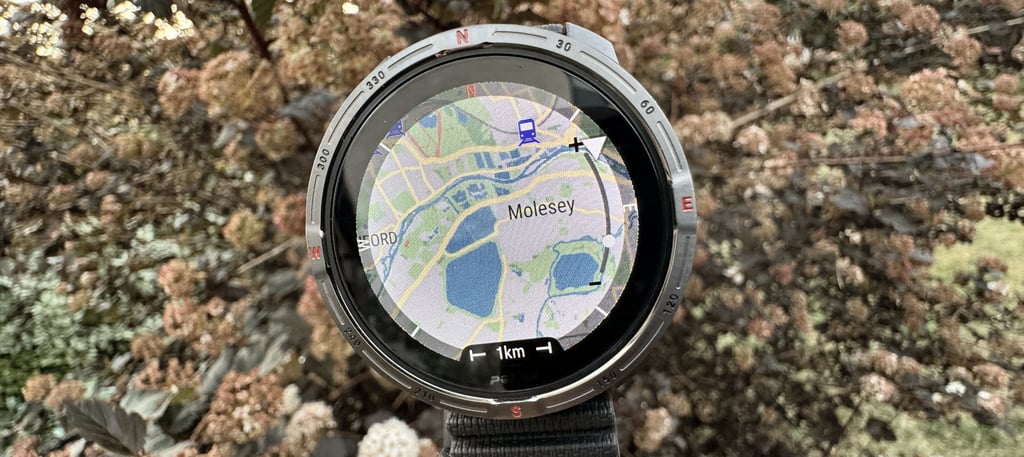 Polar Grit X2 Sports Watch Review: Best Value for Outdoor Enthusiasts?
Polar Grit X2 Sports Watch Review: Best Value for Outdoor Enthusiasts?
Grit X2 is the 2025 addition to Polar’s Grit series of outdoor watches. It sits as Polar’s most compact outdoor watch to date, built for comfort, rugged conditions, and everyday wear. This watch is suitable for both weekend warriors and advanced athletes. It incorporates Polar’s excellent suite of features, including navigation, biosensing, and specialised training and recovery tools.
This review of the Grit X2 will cover Polar’s design, build quality, setup, ease of use, features, performance (including GPS accuracy, heart rate monitoring, and battery life), real-world testing results, comparisons with alternative watches, value and pricing, and considerations for long-term use. The goal is to provide insights from a fellow athlete and adventurer, helping potential buyers understand what the Grit X2 offers and how it supports various uses.
Polar Grit X2 Review
Well-Made & Durable, Fantastic Features, Great Price, Perfect for Weekend Warriors
Verdict: The Polar Grit X2 delivers a great feature set, mirroring Polar’s top outdoor model, the Grit X2 Pro, in a more wearable and significantly more affordable package. This makes it a compelling option for outdoor enthusiasts, despite some minor performance and UI quirks.
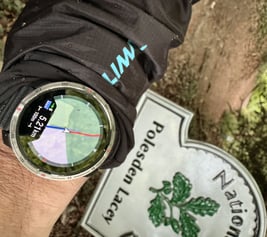
Best For: Outdoor adventurers and athletes seeking a rugged yet comfortably sized watch with comprehensive training, recovery, and navigation features, particularly if they are already within the Polar ecosystem or are looking for a premium experience at a more accessible price point than the Garmin Fenix 8.
Pros
- Reasonably compact and lightweight design for an outdoor watch
- Significantly more affordable than the Grit X2 Pro, launching at €479.90.
- Complete Polar feature set, including navigation, biosensing, and training/recovery tools.
- Superb AMOLED display protected by excellent sapphire crystal glass.
- Latest gen dual-frequency GPS
- Full-colour offline topo maps
- Polar Elixir biosensing platform – 4th Gen OHR, wrist-ECG, SpO₂, and skin temperature.
- MIL-STD-810H ruggedness certification.
- WR50/50m water resistance
- Good battery life for various modes.
- 32 GB of internal storage for maps, routes, and data.
- Supports over 170 sport profiles and dedicated performance tests.
- Integrates with the Polar Flow ecosystem (app and web).
- Compatible with third-party BLE sensors and data export to platforms like Strava, Komoot, TrainingPeaks, Apple Health, Google Fit, and MyFitnessPal.
Cons
- Wrist-based optical heart rate (OHR) accuracy varies by person, environment, and use case.
- The Polar Flow app and watch user interface are visually dated.
- Turn-by-turn guidance cannot be created on the watch. It comes from Polar Flow or the source.
- No onboard music storage or native contactless payment features.
- No US availability at launch.
Design and Build Quality
The Polar Grit X2 is its most compact outdoor watch to date, designed for comfort, durability, and everyday wear. It is less rugged-looking than previous Grit models, being more refined and perhaps even elegant.
In terms of physical specifications, the Grit X2 has a 45 mm diameter case (12.5 mm thick), which is usually classified as smaller than average, but it feels and wears larger. It weighs 62 g with the wristband and 39 g without, which is pretty light for this kind of watch and lighter than the Grit X2 Pro, which weighs 79 g with the band and 57 g without. The bezel is made of stainless steel and features compass markings. The wristband is a standard 22 mm silicone band, accompanied by an extra, shorter strap in the box. The watch is available in Night Black and Brown Copper colours.
X2 features a good-sized 1.28″ AMOLED display (416×416px resolution). Its highlight is a superior, scratch-resistant sapphire crystal glass, and gone are the oversized bezels from years past. This watch looks GREAT. There is no hardware flashlight found on the more expensive Garmin models. However, a display-based virtual flashlight is bright enough to navigate a dark tent, but not for illuminating an evening run. The display offers two core modes: gesture-based backlight and always-on; the former extends battery life.
Controls are handled through five dedicated buttons and a touchscreen. It’s a good touchscreen but perhaps best used for smart features, whereas the sports features are more easily accessed with buttons, especially when wearing gloves. The touchscreen is disabled during water sports, such as swimming.
Physical certifications include MIL-STD-810H durability and WR50 waterproofing (the Grit X2 Pro was rated WR100); environmental temperatures are supported from -20°C to +50°C.

Setup and Ease of Use
Turn the watch on, and you are ready to pair. Changing the default strap or creating a new Polar Flow account are both easy. However, there is one tip for first-time pairing with the FLOW app (iOS/Android). When prompted to match the PINCODEs, press the button first on the watch, then on the app. I prefer setting up with the PC-based FLOWSYNC, but I believe that product is being sunsetted, so we will all rely on the smartphone app at some point. FLOWSYNC can be quicker and is the best way to tweak some of the map setups.
The watch is very straightforward to use; its menus are easy and intuitive to learn. My partner and I both like the smartphone app and its organisation, but I know others don’t. The web-based FLOW platform offers additional features and plans not available on the app, and it also has some quirks in its organisation; yet, it is generally easy to use. Polar appears to be revamping multiple parts of its ecosystem; I’d perhaps prefer a more major overhaul.
Features and Performance
Grit X2 is packed with numerous detailed training, recovery, and outdoor features that are easy to use, many of which are backed by Polar’s extensive scientific research over the past few decades. Its insights leverage onboard sensors and especially the relatively new Polar Elixir biosensing platform. External sensors, such as the excellent Polar H10 heart rate strap, can be used, and I always recommend chest straps for workouts.
GPS Accuracy & The Performance of GPS-related Features
Polar confirmed to me the watch still features Sony’s CXD5610GF dual-frequency GPS, which Dcrainmaker (reviewer) notes has a newly integrated ring antenna. It’s latest-gen tech that supports multiple global navigation satellite systems (GNSS).
It comes with full-colour offline topographic maps for Europe and North America pre-installed, with free downloadable maps available for other regions. Contours and POI layers are included, but the maps lack routing intelligence. This means that X2 understands how to follow turns when following a route, but it lacks the understanding that those turns correspond to a fork in the trail or a road junction; to X2, it’s just another GPS point. Thus, if you get lost, it can only point your back to the route in a straight line or retrace your footsteps.
A slight calibration of the compass is also required before using route navigation.
External routes from Polar Flow, Komoot, or Strava should contain turn-by-turn cues. However, cleverly, when you load a GPX file on the X2 via Polar Flow, the latter automatically adds the turn instructions. There are several related features, including breadcrumb trails, real-time elevation profiles, a built-in barometer, and a compass view.
Polar’s maps are visually appealing and easy to follow in non-technical situations. However, on a lightly technical trail, I found the maps lacked sufficient context for me to know exactly where to turn when moving at a good pace. For non-time-critical hiking over well-used routes, all will be good; less so for technical, trail runners relying on the map.
In my testing, GPS accuracy for running, open-water swimming, cycling, and hiking was better than I expected. In comparison to reference devices from Apple, Wahoo, and Garmin, the Polar performed nearly as well in all scenarios. Polar’s recorded tracks were more jagged and didn’t look as good, and were sometimes not quite as good in challenging conditions with extensive tree cover.
In comparison to a Suunto RUN in a buoy, the Grit X2’s track was closer and better than the Garmin Forerunner 970, but again, it produced a more jagged track. Open-water swimming challenges GPS accuracy, so I ensured good reception before jumping in and getting started quickly. Extended seconds of submergence can make it very difficult for the watch to recover its position, and the watch on the other wrist could be significantly favoured, much more so than in land-based sports.
Cycling and running accuracy in the open were good, but the Grit X2 suffered more under trees and, to an equally significant extent, when near tall buildings. I’ll add some more charts here over the next few days.
Here are some examples for now.
Heart Rate Monitoring
Polar’s Elixir biosensor boasts multiple capabilities, including 4th Gen Optical Heart Rate (OHR), wrist-ECG, HRV/RR, SpO₂ (blood oxygen saturation), and nightly skin temperature tracking. The OHR sensor has been redesigned to limit light leakage, and its algorithms tweaked to reduce motion artefacts. The platform also provides HRV measurement for stress and recovery insights.
Novel Feature: Elixir corrects data after it has been displayed onscreen and before recording. There are issues with this approach, but they are outweighed by the greater good of having more accurate data for Polar’s workout and load algorithms. I tested this feature on an earlier watch but noted little difference.
OHR accuracy during workouts
Polar’s chest straps and arm bands work perfectly on me, but I don’t get on with their wrist tech…or anyone else’s, for that matter. Perhaps my wrists are too slender, too slippery, or the bounces and knocks from my various activities are too much. I thought I had managed a good HR track while open-water swimming; however, I only had one reference track, a Garmin HRM PRO Plus, and that was incorrect when retrieving data from its cache, so I’m unsure.
From some other reviewers, I get the sense that you might achieve good activity-based HR in some circumstances. However, even then, some of the subtle nuances or high-activity-level data might still be incorrect.
Those who want an accurate heart rate recording when lifting in the gym should consult the science. Correctly recorded heart rate when lifting cannot determine muscular strain or load, and calorie calculations from any wearable device during lifting are incorrect. Polar uses a model to assess muscular strain based on power and RPE, but it is effectively impossible for reviewers to validate. The model sounds better than those used by other brands, except Whoop, which should give the most accurate measures of muscular strain when following a pre-planned strength workout (it uses VBT principles).
Swim metric accuracy
One of the charts in the previous section shows pool-based OHR in a 36m pool. X2 is not so bad and on par with Garmin Elevate 5. I would not want to use either; the armband and chest strap alternatives are superior.
Polar’s swim data does not correctly record rest time between sets. It underestimated it. Thus, making comparisons of any piece of data difficult. If you are a serious swimmer looking for stroke statistics, the Polar data is inaccurate based on one session of swimming at a 1:30-1:45/100m pace with some lane traffic. Stroke detection was 100% correct, however.
Observation during sleep, rest and other tests
Cursory checks of this information suggested it was in line with expectations.
The wrist-ECG does not determine Afib events and is more of a high-resolution HRV sensor than a true ECG.
Sleep tracking accurately recognised the correct sleep/wake times, and the sleep stage chart appeared broadly similar to those of other devices (none are entirely accurate, however, as it’s not possible to accurately determine sleep stages to a high degree of accuracy with a wearable device). REM sleep is challenging for wearables to determine correctly.
Elevation
For hiking and cycling, the weekend warrior will be pleased with the elevation profiles produced by Grit X2. Elevation deltas result from changes in barometric pressure, so these charts also indicate that the barometer is functioning correctly.
Battery Life
The Grit X2 features a 310 mAh rechargeable battery, which is smaller than the 488 mAh battery in the Grit X2 Pro. It offers up to 30 hours of use in Performance training mode with full GPS, up to 90 hours in Eco training mode, and up to 7 days in Smartwatch mode. These figures are shorter than the Grit X2 Pro’s 43 hours, 140 hours, and 10 days, respectively.
This is not a market-leading battery performance compared to select Coros, Garmin or Suunto watches, but it is pretty good and more than acceptable for me. Often, you will find that the way you use your Always-On display, for say, Garmin, will drastically reduce the actual battery life you get. That said, I felt that Polar was performing roughly in line with its claims. However, better performance degrades over time as the watch goes through multiple charge cycles. Polar has a significant differentiator here in that its batteries are factory-replaceable.
The watch can be charged during training sessions, whether paused or active.
Training Tools
The watch offers a comprehensive suite of science-based training and recovery features:
- Training Load Pro for monitoring training strain.
- Recovery Pro and Orthostatic Test to assess recovery status. The latter is better for athletes looking to evaluate the state of their exercise physiology. Overnight recoveries are better for determining resting physiology.
- Nightly Recharge and Sleep Plus Stages for overnight recovery and sleep analysis.
- SleepWise provides insights into sleep rhythm and daytime alertness.
- FitSpark for personalised daily workout suggestions across a range of activity types.
- Free Running Programs
- Wrist-based Running Power as a free alternative to the (likely) more accurate Stryd.
- Running Index for tracking aerobic fitness.
- FuelWise and Energy Sources for fueling reminders and post-session macronutrient breakdown.
- Hill Splitter, VAM, Vertical Speed, and 3D Speed for performance metrics in varied terrain.
- Swimming metrics, including pace, stroke, style, distance, and rest tracking, with detailed style breakdowns available in the training summary.
- Support for over 170 sport profiles, with customisable training views for each.
- Dedicated performance tests, including walking, running, cycling, and leg recovery (jump test).
- Voice guidance is available during sessions when paired with a connected phone.
- The Work-Rest Guide helps track sets and rest times during strength training.

Smart Features
Beyond sports tracking, the Grit X2 includes some core smartwatch features:
- Receive call, message, and app notifications from a paired phone.
- Control music playback on a paired phone (no onboard music storage).
- View the weather forecast.
- Activate a display-based flashlight mode.
- Customise watch faces and widgets for quick access to data.
- Receive over-the-air software updates.
- Includes a Find My Phone feature to locate a misplaced phone.
- Allows for HR broadcasting to external Bluetooth sensors or gym equipment.
- Offers a PIN code option for enhanced data privacy when the device is not on the wrist.
- Features such as planned training reminders and “Forgot Phone” alerts are available via internal notifications.
The watch does not support native contactless payments but is compatible with Fidesmo Pay-enabled wristbands.

Comparison with Alternatives
Here are my thoughts on some of the choices available to you
Grit X2 vs X2 Pro
This is an “either or” choice, with size and price being deciding factors
The Polar Grit X2 is positioned as a smaller, lighter, and significantly more affordable alternative to the Grit X2 Pro. Crucially, it shares the same core feature set as the Grit X2 Pro, including the processor, RAM, storage, GPS type, biosensing platform, training and recovery tools, navigation, and smart features. The main differences lie in physical size, weight, battery life (shorter on X2), water resistance (50m vs 100m), and display size (1.28″ vs 1.39″). OHR performance with the same sensor is similar across these models.
Grit X vs X2
This is a choice on whether to upgrade. Yes, there are many benefits to upgrading.
Compared to the original Grit X, the Grit X2 boasts an AMOLED display, sapphire glass, a faster processor, dual-frequency GPS, increased storage, maps, USB-C charging, and the Elixir sensor suite. However, the original Grit X had 100m water resistance and a longer listed battery life.

Grit X2 vs Polar Range
Within Polar’s lineup, the Grit X2 shares the latest Polar OS4 software platform and many features, including maps and the Elixir sensor, with newer models like the Vantage V3 and Vantage M3. The Grit X2 is a sports watch designed for adventures, whereas the M3/V3 represent cheaper and more expensive alternatives with a sports-focused design. X2 features durability enhancements, including sapphire glass and a stainless steel bezel, compared to the Vantage M3.
Grit X2 vs Competition
The current generation Apple Watch Ultra and Garmin Fenix watches are significantly more expensive. High-end Garmin watches, such as the Fenix 8 (€1,099.99) or Forerunner 970, offer similar high-level features, including sapphire glass and maps. However, Garmin’s ecosystem is more evolved and caters for every niche need.
At the same price tier as the Grit X2, you would need to buy an older generation Garmin; something like the Epix Pro Gen 2 is worth considering. However, older Garmin devices tend not to receive new feature updates.
If you were to consider an Apple, you would find the sport and navigation features to be notably inferior (but they might still be all you need). However, Apple’s integration with its broader ecosystem, especially the iPhone, is superior.
The most similar competitor is probably the Suunto RACE S (€469). Suunto’s new Chinese owners appear to have jump-started the company over recent years, and it has perhaps moved ahead of Polar in some ways, as its on-watch ecosystem and phone app have become more refined. I especially like Suunto’s app store, which is a bit difficult to navigate but does offer many niche features.
FAQs
- Is the Polar Grit X2 compatible with third-party apps, such as Strava, Komoot, or TrainingPeaks? Yes, the Grit X2 is compatible with Polar Flow, which serves as a bridge for two-way syncing of data to popular platforms, including Strava, Komoot, TrainingPeaks, Apple Health, Google Fit, and MyFitnessPal.
- Can it track open-water swimming? Yes, it has swimming metrics.
- Can the watch track strength training? Yes, it has a strength training sport profile and features like the Work-Rest Guide.
- What is Polar Flow? Polar Flow is Polar’s ecosystem (mobile app and web service) used for syncing, viewing, analysing, and planning training, activity, sleep, and routes.
- Does Grit X2 have maps and navigation features? Yes, it includes full-colour offline topographic maps, turn-by-turn guidance, breadcrumb trails, elevation profiles, a barometer, a compass, and Points of Interest.
- What is Polar Elixir? Polar Elixir is the watch’s integrated biosensing platform that includes optical heart rate (OHR), wrist-ECG, blood oxygen saturation (SpO₂), and skin temperature tracking.
- Is the battery replaceable? Yes, the rechargeable battery is replaceable via Polar Service.
- Is it waterproof? The Polar Grit X2 has a water resistance rating of 50 meters, suitable for swimming.
- Does it have onboard music storage? No, the watch does not have storage for music files, but it does offer controls for music playing on a paired smartphone.
- Can I use it for contactless payment? No. The watch itself does not have native contactless payment capabilities, but it is compatible with Fidesmo Pay wristbands, which lack biometric authentication.
References, Resources & Links
Buy Polar Grit X2 – Value and Pricing
The Polar Grit X2 is launched in Europe at a retail price of €479.90, a modest €50 price increase over the original Grit X for a superior package. But X2 represents a substantial price drop compared to the Grit X2 Pro’s launch price of €749.90 to what is essentially the same, but smaller, product.
The pricing is a recognition of market reality. Coros, Suunto, Polar and others compete in a similar space. The Garmin premium positions its watches within a superior ecosystem, which sets it apart, almost in an entirely different market.
Affiliate Disclosure: This watch is a media loaner, and the content has not been paid for or incentivised by polar in any other way. I use affiliate links, which earn commission at no extra cost to the reader. This supports the work here.
Updates & Long-Term Use Considerations
The Grit X2 runs on the latest Polar OS4 software platform, which is also used by other high-end Polar watches, rolled out throughout 2025. The watch is designed to receive future feature updates and long-term support from Polar. Polar has historically pushed out firmware updates that include new features, improvements, and bug fixes. Polar OS4 itself includes various new features, some of which were previously announced under the OS3 label.
I doubt we will see a new generation of high-end Polar hardware until 2026 at the earliest.
The polar ecosystem has been undergoing a gradual refresh in recent months as part of an ongoing process. I doubt the company will give the ecosystem the aesthetic overhaul it perhaps needs. That said, the watch hardware looks great; it just needs some decent watch faces or a mechanism for 3rd parties to add them.
Polar Grit X2 – Take Out
Well-Made & Durable, Fantastic Features, Great Price, Perfect for Weekend Warriors
The Polar Grit X2 is a great athletic performance tracking watch and a fairly comprehensive outdoor offering in a smaller, lighter, and much more affordable package than its Pro counterpart. Its robust MIL-STD-810H certified design, sapphire crystal glass, AMOLED display, and dual-frequency GPS make it a capable companion for outdoor adventures. Features like offline maps with turn-by-turn guidance and the full Elixir biosensing platform (OHR, wrist-ECG, SpO₂, skin temp) provide powerful tools for navigation, training, and recovery, with splashes of excellence mixed with dashes of ‘could do betters’. The competitive pricing transforms Grit X2 Pro from over-priced to highly competitive.
Who Should Get It: The Polar Grit X2 is a watch designed for outdoor enthusiasts or those who appreciate the outdoor aesthetic. As always, Polar serves athletes who value a durable, capable sports watch boosted by navigation tools. Polar was keen to highlight that the more compact size targets women with smaller wrists. For anyone invested in the Polar Flow ecosystem, this is a worthwhile upgrade for a purchase made in 2020 or earlier.
Who Should Skip It: If you’re looking for a deeply integrated smartwatch, consider Apple, Google, or Samsung. Similarly, if you have unusual sports needs, Garmin is likely the best place to start your search. There are potentially more accurate devices available for measuring optical heart rate levels. Still, I don’t see that as a reason to consider a different brand, which may present similar or different accuracy issues. For those seeking precise sleep and sports heart rate tracking, I encourage you to understand the limitations and science behind this field to ensure you get what you think you are buying. Finally, Polar maps and a lack of onboard map intelligence put it at a disadvantage for those adventurers and explorers who need the most complete mapping capabilities on the wrist… or you could use your phone.
I like it. It looks great and has that feature Garmin lacks…ease of use. That’s the feature you use every day, right?


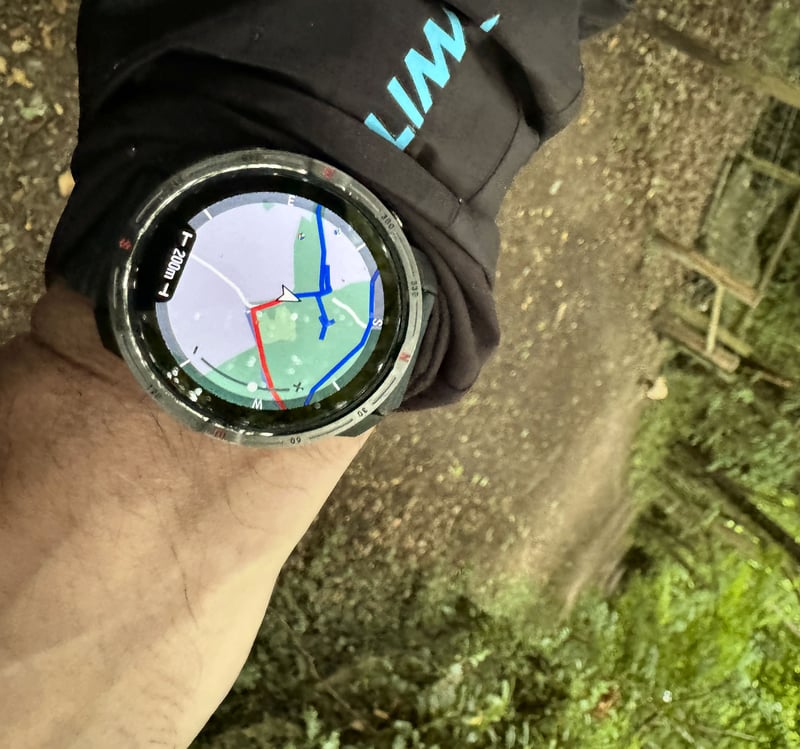
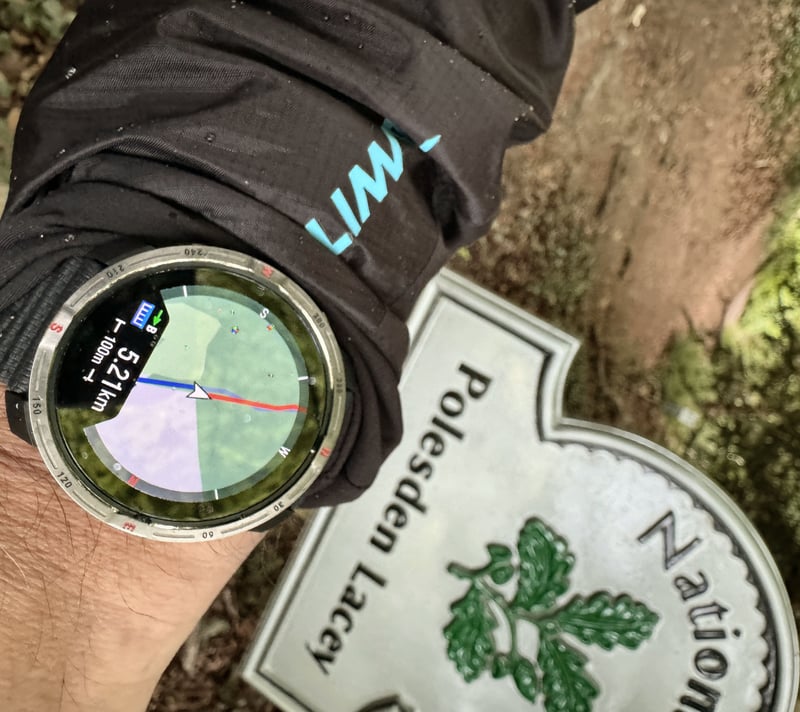
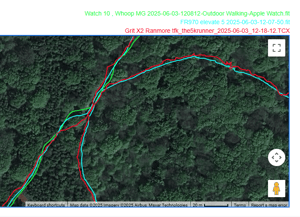
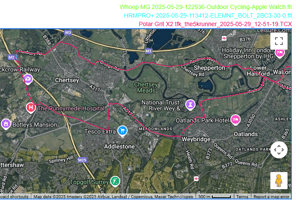
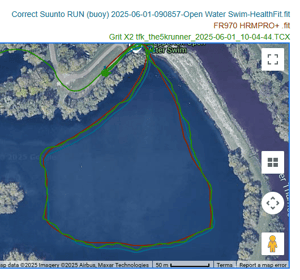
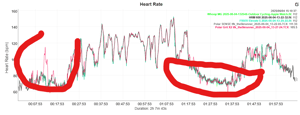
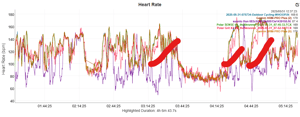
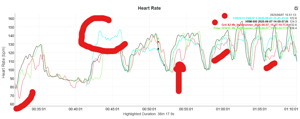
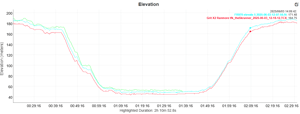
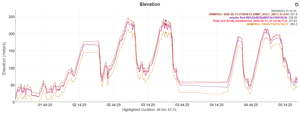
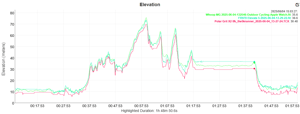
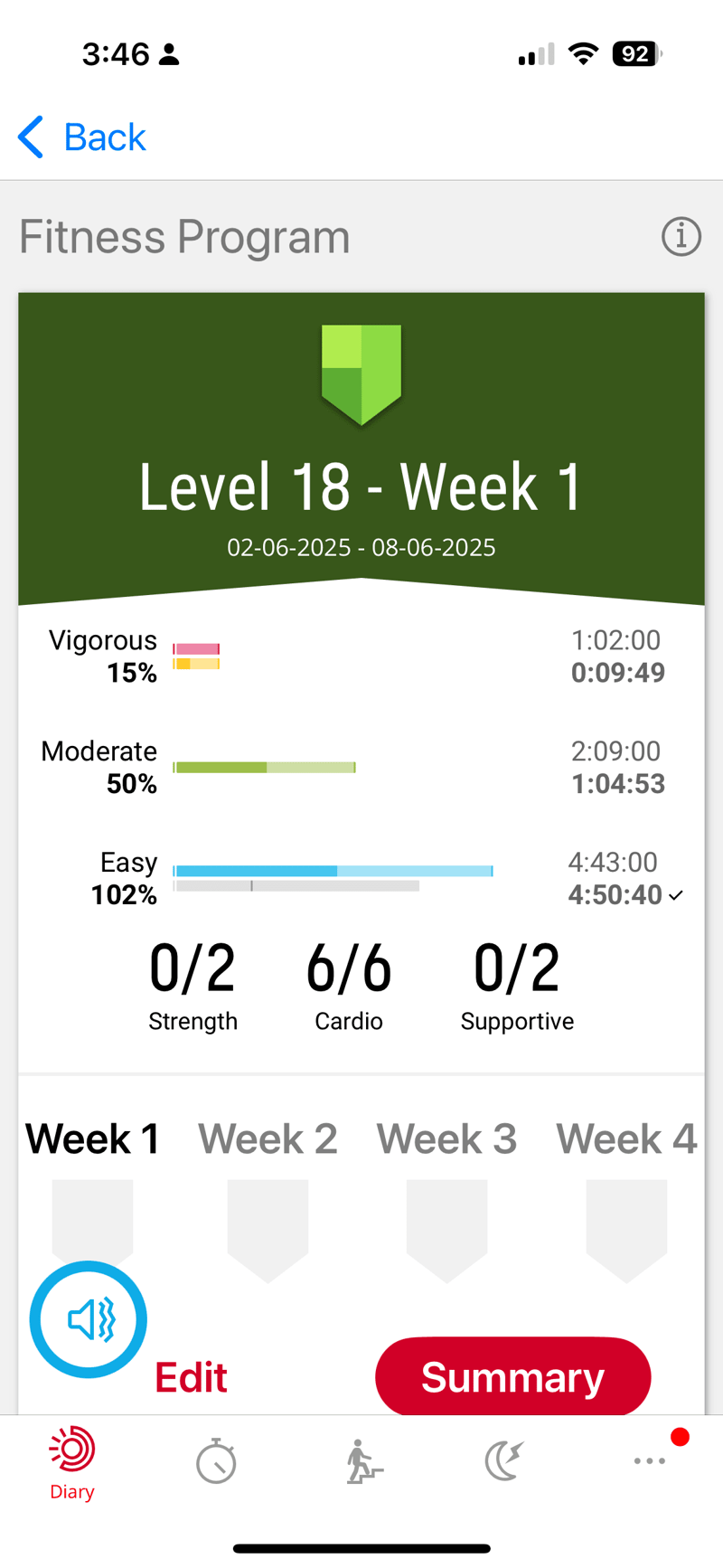




The biggest con…no build-in dedicated flashlight…the screen based torch is better than nothing…but it can’t hold a candle to the Garmin torch…literally.
One of the biggest issues for me with the Polar Grit X Pro was the problematic integration with indoor trainers (power, cadence and speed — in my case it was Elite Suito). Have you had a chance to test it with the new GX2 yet?
Mr 5k, its not 4th gen biosensing or elixir. 4th gen is ohr only, spo2, skin temp, EKG is 1gen. For now elixir is labelled as it is, without number.
thank you i will adjust accordingly: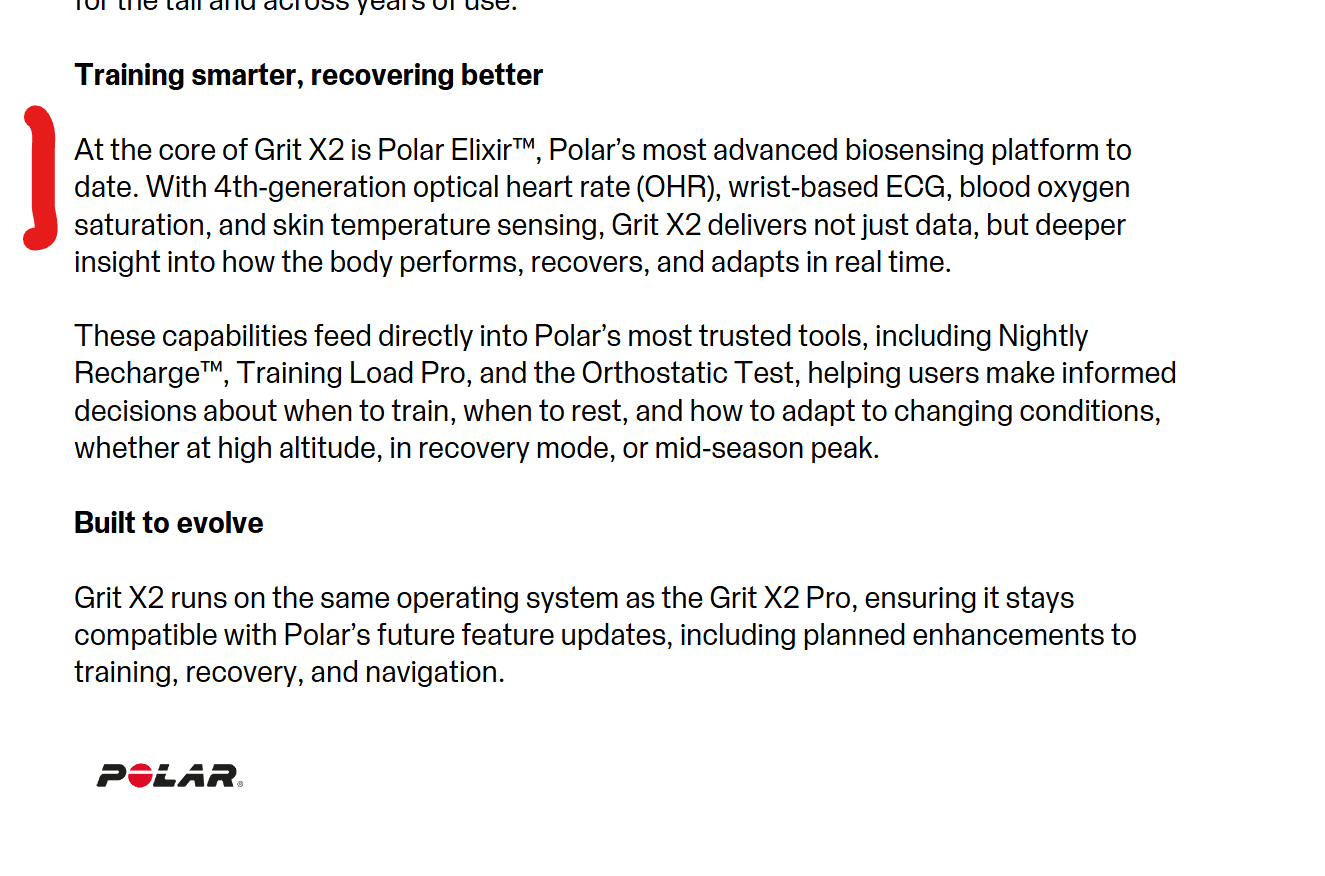
When you click on “compare” on Polar website there are all labelled as 4gen (ohr) or 1gen (temp, spo2,EKG).
yes
i look forward to you completing another 5k and commenting as the20krunner.
polar should have simply called the whole sensor array Fourth Gen and be done with it. other companies would do that. for brevity, if nothing else